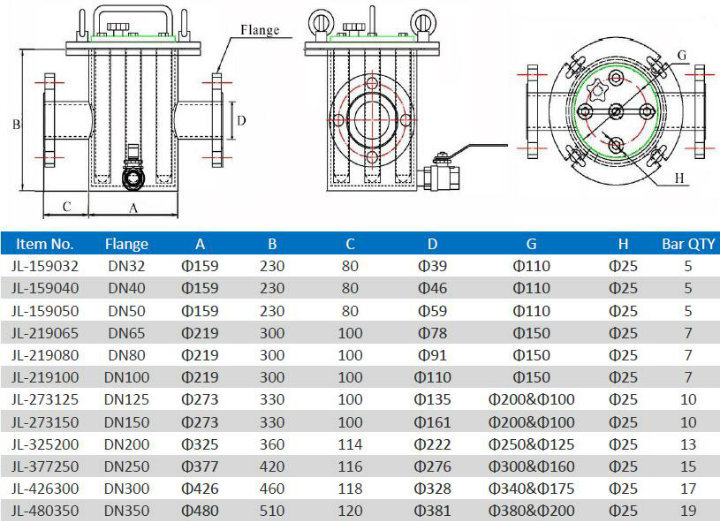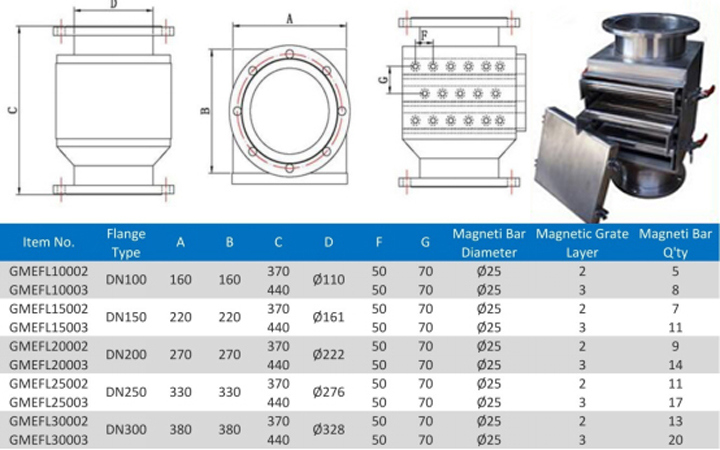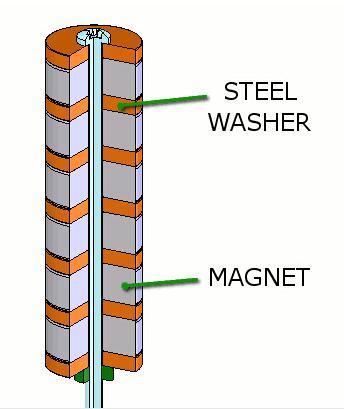Fluid/Air/Water/Powder Fernox Iron Remover Filtration Magnetic Filters Separators
Fluid/Air/Water/Powder Fernox Iron Remover Filtration Magnetic Filters Separators:
Specification:
Liquid line magnets are available in line sizes from 1-1/2" to 8" diameter. Standard 2", 3" & 4" Line Diameter, 1/2″ and other sizes available upon request. 2″ Diameter is available for immediate shipment.
Fluid/ Air  / Water/ Agizing/ Slurry Type:
Powder Type:
1. AdaptationPipe sizing agent de-ironing separator product description and schematic way.
Pipe magnetic filter (Pipe sizing agent separator) is mainly used to clear sizing agent, flake and granular material in the ferromagnetic impurities, widely used in ceramics, electricity, mining, plastics, chemicals, rubber, pharmaceutical, food, environmental protection, pigments, dyes, electronics, metallurgy and other industries.
2. How it works:
Pipe sizing agent separator is made of stainless steel tube and high B value NdFeB rare earth alloy materials, and the use of special production methods made of magnetic filter rods (bar magnet), fixed made from high quality stainless steel sheet framework, constitute a magnetic filter.
Use flange be installed in the production line or in the pipeline at the discharge port, when the iron-containing material through, attracted by the magnetic bar, the iron-containing material firmly onto the wall, in order to ensure the integrity of the equipment and products safety.
3. Product Features:
No energy, no pollution, simple structure, can be installed on the production line or in the pipeline at the discharge port, save space, easy to install, use staggered arrangement of the magnet, the magnetic spacing well-designed, so that magnetic region can be more fully utilized .
4. Pipe separator and delivery specifications Description:
Separators pipeline specifications are more specific size according to customer design and manufacture of the actual situation. After less than three orders and check it back in 3 weeks for delivery.
We also offer OEM service, according to demand and drawing from clients.The related products you may interest:

How do magnetic bar work?  How are magnetic bar constructed?
Typical construction of a magnetic bar is shown.
Not shown is the 304 stainless steel tube in which this stack of magnets and steel washers (or pole pieces) is inserted.
Most of the grates are made with tubes of non-magnetic stainless steel with an assembly of magnets inside.
The stainless is sealed shut, usually with a weld, which keeps the magnets free from contamination.
The magnets inside the tube are usually arranged in a row, usually with ring magnets sitting on a shaft. 
The magnetization direction each successive magnet is assembled in the opposite direction, so that the direction alternates with each magnet.
This specific arrangement is used to create a powerful magnetic field around the assembly.
It produces an extremely high magnetic field right at the steel "pole pieces," and can exceed 10,000 gauss, even 12000 gauss!
Tiny bits of iron and steel are attracted to the magnet, with the most force in the locations where the magnetic field strength changes the most.
Near the pole pieces, this setup can exert a very strong hold onto even fairly small pieces of iron or steel. 
Why are they constructed this way?
So many made with this sort of arrangement, its wide use is taken for granted.Â
Strong magnetic field as far out as possible from the tube, to catch ferromagnetic particles from as far away as possible.Â
This setup uses common, axially magnetized ring magnets to produce a magnetic field in a region around the cylinder. Â
It is also strong all the way around the circumference of the cylinder, unlike a diamagnetic magnet, which is strongest at two points (the poles located 180° apart).
The second, it has to do with holding onto the bits of iron or steel to the magnet after they are caught.Â
The force exerted on a tiny bit of iron depends on both the field strength and the field strength gradient at given location near the magnet.
The gradient is how much the field strength is changing with distance from the magnet.
Â
GME core values
Customer Care
Quality is our life. Customer satisfaction is our eternal pursuit. Everything we do at GME is driven by an unyielding passion for excellence in identifying and delivering solutions that exceed expectations.
Innovation
In today's fast-developing global economy, innovation is critical to a company's survival. We anticipate and adapt to changing for continuous improvement.
Co-Prosperity
A business cannot be successful unless it creates prosperity and opportunity for others. We have a dream--customers could win more through our Great Service; we have a dream--GME members could realize their own dreams while striving for GME Dream.
Social Responsibility
Sustainability isn't only important for people and the planet, but also is vital for business success. We are environmentally responsible and drive to sustainability. And we should do something for our better future.
For more information, please refer to www.greatmagtech.com
Fluid/Air/Water/Powder Fernox Iron Remover Filtration Magnetic Filters Separators:
Specification:
Liquid line magnets are available in line sizes from 1-1/2" to 8" diameter. Standard 2", 3" & 4" Line Diameter, 1/2″ and other sizes available upon request. 2″ Diameter is available for immediate shipment.
Fluid/ Air  / Water/ Agizing/ Slurry Type:
Powder Type:
1. AdaptationPipe sizing agent de-ironing separator product description and schematic way.
Pipe magnetic filter (Pipe sizing agent separator) is mainly used to clear sizing agent, flake and granular material in the ferromagnetic impurities, widely used in ceramics, electricity, mining, plastics, chemicals, rubber, pharmaceutical, food, environmental protection, pigments, dyes, electronics, metallurgy and other industries.
2. How it works:
Pipe sizing agent separator is made of stainless steel tube and high B value NdFeB rare earth alloy materials, and the use of special production methods made of magnetic filter rods (bar magnet), fixed made from high quality stainless steel sheet framework, constitute a magnetic filter.
Use flange be installed in the production line or in the pipeline at the discharge port, when the iron-containing material through, attracted by the magnetic bar, the iron-containing material firmly onto the wall, in order to ensure the integrity of the equipment and products safety.
3. Product Features:
No energy, no pollution, simple structure, can be installed on the production line or in the pipeline at the discharge port, save space, easy to install, use staggered arrangement of the magnet, the magnetic spacing well-designed, so that magnetic region can be more fully utilized .
4. Pipe separator and delivery specifications Description:
Separators pipeline specifications are more specific size according to customer design and manufacture of the actual situation. After less than three orders and check it back in 3 weeks for delivery.
We also offer OEM service, according to demand and drawing from clients.The related products you may interest:

How do magnetic bar work?  How are magnetic bar constructed?
Typical construction of a magnetic bar is shown.
Not shown is the 304 stainless steel tube in which this stack of magnets and steel washers (or pole pieces) is inserted.
Most of the grates are made with tubes of non-magnetic stainless steel with an assembly of magnets inside.
The stainless is sealed shut, usually with a weld, which keeps the magnets free from contamination.
The magnets inside the tube are usually arranged in a row, usually with ring magnets sitting on a shaft. 
The magnetization direction each successive magnet is assembled in the opposite direction, so that the direction alternates with each magnet.
This specific arrangement is used to create a powerful magnetic field around the assembly.
It produces an extremely high magnetic field right at the steel "pole pieces," and can exceed 10,000 gauss, even 12000 gauss!
Tiny bits of iron and steel are attracted to the magnet, with the most force in the locations where the magnetic field strength changes the most.
Near the pole pieces, this setup can exert a very strong hold onto even fairly small pieces of iron or steel. 
Why are they constructed this way?
So many made with this sort of arrangement, its wide use is taken for granted.Â
Strong magnetic field as far out as possible from the tube, to catch ferromagnetic particles from as far away as possible.Â
This setup uses common, axially magnetized ring magnets to produce a magnetic field in a region around the cylinder. Â
It is also strong all the way around the circumference of the cylinder, unlike a diamagnetic magnet, which is strongest at two points (the poles located 180° apart).
The second, it has to do with holding onto the bits of iron or steel to the magnet after they are caught.Â
The force exerted on a tiny bit of iron depends on both the field strength and the field strength gradient at given location near the magnet.
The gradient is how much the field strength is changing with distance from the magnet.
Â
GME core values
Customer Care
Quality is our life. Customer satisfaction is our eternal pursuit. Everything we do at GME is driven by an unyielding passion for excellence in identifying and delivering solutions that exceed expectations.
Innovation
In today's fast-developing global economy, innovation is critical to a company's survival. We anticipate and adapt to changing for continuous improvement.
Co-Prosperity
A business cannot be successful unless it creates prosperity and opportunity for others. We have a dream--customers could win more through our Great Service; we have a dream--GME members could realize their own dreams while striving for GME Dream.
Social Responsibility
Sustainability isn't only important for people and the planet, but also is vital for business success. We are environmentally responsible and drive to sustainability. And we should do something for our better future.
For more information, please refer to www.greatmagtech.com
During this initial phase, Design Engineers, Tooling Engineers, Materials Engineers, Manufacturing Engineers, Quality Engineers, and Lab Technicians work together to determine product specifications, tooling component capabilities, tooling materials, operating limitations, and any required product enhancements and improvements. The team specifically looked for any potential issues with part geometry or tolerances that could result in poor steel condition or require special tool features such as lifters, slides and threading/unthreading. The physical and chemical properties of the selected resins are also evaluated in order to select suitable mold steels and review mold cooling. In addition to determining the proper vent location, a mold flow evaluation is performed to determine the optimal gate type and gate location.
The manufacturability review includes the validation of standard plastic design practices and the incorporation of tooling details to create the most robust design possible. Tool specifications and tool provenance are finalized and purchased component sources are qualified. A comprehensive Process Failure Mode Effects Analysis (PFMEA) was also completed.

Automobile Plastic Parts,Plastic Injection Molded Automotive Parts,High Precision Abs Injection Plastic Molded Parts,Custom Injection Molded Plastic Abs Parts
Suzhou Dongye Precision Molding Co.,Ltd. , https://www.sjinjectionmolding.com